The Pressures on American Monetary Policy
Autor Thomas Havrileskyen Limba Engleză Hardback – 30 dec 1992
| Toate formatele și edițiile | Preț | Express |
|---|---|---|
| Paperback (2) | 948.79 lei 6-8 săpt. | |
| Springer Us – 2 mar 2013 | 948.79 lei 6-8 săpt. | |
| SPRINGER NETHERLANDS – 2 oct 2012 | 1221.51 lei 6-8 săpt. | |
| Hardback (2) | 955.08 lei 6-8 săpt. | |
| Springer Us – 30 dec 1992 | 955.08 lei 6-8 săpt. | |
| SPRINGER NETHERLANDS – 30 apr 1995 | 1227.99 lei 6-8 săpt. |
Preț: 955.08 lei
Preț vechi: 1164.73 lei
-18% Nou
Puncte Express: 1433
Preț estimativ în valută:
182.75€ • 190.81$ • 151.25£
182.75€ • 190.81$ • 151.25£
Carte tipărită la comandă
Livrare economică 04-18 aprilie
Preluare comenzi: 021 569.72.76
Specificații
ISBN-13: 9780792393009
ISBN-10: 0792393007
Pagini: 372
Ilustrații: X, 372 p.
Dimensiuni: 155 x 235 x 22 mm
Greutate: 0.72 kg
Ediția:1993
Editura: Springer Us
Colecția Springer
Locul publicării:New York, NY, United States
ISBN-10: 0792393007
Pagini: 372
Ilustrații: X, 372 p.
Dimensiuni: 155 x 235 x 22 mm
Greutate: 0.72 kg
Ediția:1993
Editura: Springer Us
Colecția Springer
Locul publicării:New York, NY, United States
Public țintă
ResearchDescriere
The basic motivation for this book is my lifelong interest in the relationship between political processes and macroeconomic outcomes, especially in the area of monetary policy. Monetary policy is an area where political considerations regularly impact upon economic results. When my fascination with this subject began thirty years ago, none of the scholarly literature of that period engaged in modeling monetary policy, even as a constrained maximization problem, not to mention systematically linking it to politically-generated goals. My dissertation at the University of Illinois in 1966 and my first published article (in the Journal of Political Economy in 1967) addressed the modeling and estimation of the concerns that propel monetary policy. In the political and economic turbulence of the period from the late 1960s through the early 1980s, it became clear that the directions taken by monetary policy were changing with some frequency. Much of my published research during that period dealt with formal control theoretic models of monetary policy but some of it attempted to measure these changes and showed that monetary policy reactions to the state of the economy were not stable over time. Even during this early period I suggested reforms which might reduce the resulting instability in the economy. For example, my 1972 article in the Journal of Political Economy suggested systematic penalties Federal Reserve officials who failed to meet the goal of monetary stability by tying their budgets or salaries inversely to the rate of inflation.
Cuprins
One The Pressures on Monetary Policy: An Overview.- Two Executive Branch Pressures on Monetary Policy: 1914–1991.- Three Legislative Branch Pressures on Monetary Policy: 1914–1991.- Four Monetary Policy Signaling from The Administration to the Federal Reserve.- Five Federal Reserve Responsiveness to Threat-Augmented Signaling.- Six The Causes of Signaling from the Administration and Threats from Congress to the Federal Reserve.- Seven Monetary Policy Signaling from Congress to the Federal Reserve.- Eight Banking and Other Private Sector Influences on Monetary Policy.- Nine The Power of Appointment and Monetary Policy.- Ten Implications for Monetary Reform.
















